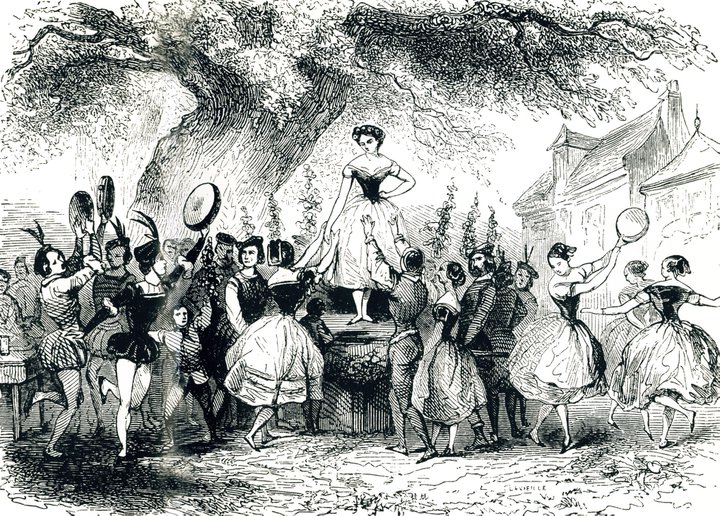APRIL 18, 2025 – Just over a year ago I took my wife and our granddaughter to see the Canadian Ballet Company perform Giselle at Northrop Auditorium on the main campus of the University of Minnesota. I featured that experience in my 3/23/24 post. I don’t remember a thing about the ballet itself, however. That’s because I didn’t attend. Because I was recovering from a horrible cough, I didn’t allow myself inside Northrop. I served merely as the chauffeur.
This evening, I was given another bite at the apple. And again, I served as chauffeur for my wife and our granddaughter to see the American Ballet Theatre perform Giselle at Northrop. This time around my sister Jenny, a violist, was in the pit.
As I listened to the excellent sound of the orchestra as it played the masterpiece ballet score by Adolphe Adam (first performed in 1841), I was reminded of my three sisters’ close associations with ballet. My oldest sister, Kristina, played in Tchaikovsky’s Nutcracker Suite hundreds of times during the decades she lived in Boston. I’m pretty sure that over her career she’s played in other ballets, as well. Also, her two daughters were serious students in the Boston Ballet Company’s youth program. My second oldest sister, Elsa, when fresh out of Curtis Institute, toured with the Pennsylvania Ballet Company. For extra credit, while a student at Interlochen Arts Academy, she roomed with (and has remained good friends with) Janet Eilber, who became a lead dancer with the Martha Graham Dance Company and in 2005 became artistic director of the Martha Graham Center of Contemporary Dance. And here’s Jenny, now, playing for the ABT’s performance of Giselle.
Me? Again, when it comes to music among the “Nilsson sibs,” I’m the odd man out—starting with the fact I’m a man and an odd one at that, whereas the other “sibs” are women and really top flight string players, though Jenny is the “odd” one among the three by the mere fact that she plays viola, whereas Kristina and Elsa stuck with the violin.
If my sisters (and for that matter, my non-violinist/violist wife) know a whole lot more about ballet than I do or ever will, I remain an expert on the subject of my own likes and dislikes, and I “liked” very much this evening’s ballet performance.
Our seats were on the fourth level, and when the curtain rose and Act One got underway, the dancers looked like miniature people on a scale model of a dance stage. As the performance progressed and I became increasingly engrossed in the extraordinary grace, strength and artistry that filled the stage, the dancers grew. I no longer felt as though we were sitting in airplane seats.
You may call me a rank neophyte when it comes to ballet, but as I watched the proceedings I was amazed by what I saw. Here were 20-some highly trained and experienced dancers who danced for 105 minutes broken only by a 20-minute intermission halfway through. Against a world in which incompetence and mediocrity; discord and the absence of cooperation are hallmarks, there on stage was yet another example of a group of human beings working an art form to perfection.
The closest physical comparisons to ballet are figure skating and gymnastics, but neither of those awe-inspiring sports involves the same level of refinement and artistry, let alone performance stamina, as ballet demands. Beyond my understanding is how all those dancers could master all the moves and patterns, then apply them cogently and artistically to the direction of a choreographer—all the while synchronizing exactly with the music.
The story—which I shan’t bore you with; if you’re that curious, just Google it and explore to your heart’s content—is very “operatic,” meaning the plot can be summed up this way: One protagonist to another: “I love you, I love you, I love you.” A jealous lover/antagonist to one protagonist: “I hate you, I hate you, I hate you.” Then someone dies and then another. As I told my wife and our granddaughter, “If you want a detailed plot [and character development], see a play [or read a novel].” In other words, the story isn’t the point.
The point of Giselle transcends the simple story line. The extraordinary beauty of what we experienced was in the discipline and artistry expressed by the human body, head to toe, in movement but also in suspended animation, coordinated among dancers and in perfect partnership with a sizable ensemble of musicians breathing (and bowing) life into thousands of non-verbal markings on row upon row of sets of five parallel horizontal lines.
I became fascinated by how dancers could use what seemed to be almost a “sleight of feet and legs” to create the illusion that each leap was levitation-assisted. By the entire production, I was mesmerized.
The capacity crowd included many students of dance and their local idols and mentors. I could tell by the way they carried themselves—something I observed among the dance majors at Interlochen when I attended the school as a violin major. In the final applause they demonstrated their enthusiastic approval of the performance. Their shouts and whoops were different from the opera crowd and the symphony crowd. I can’t put my finger on exactly what distinguishes each of these three groups from one another, but there is some palpable difference. The (dance) crowd’s strong approval of the performance gave me license to cheer unabashedly too. If the crowed had been subdued, but in my naive enthusiasm I had gone overboard with my applause, well . . . I’m glad things didn’t pan out that way. For the past two hours, I told myself, I’ve been part of the “ballet crowd,” so why not act like it?
Subscribe to this blog and receive notifications of new posts by email.
© 2025 by Eric Nilsson
